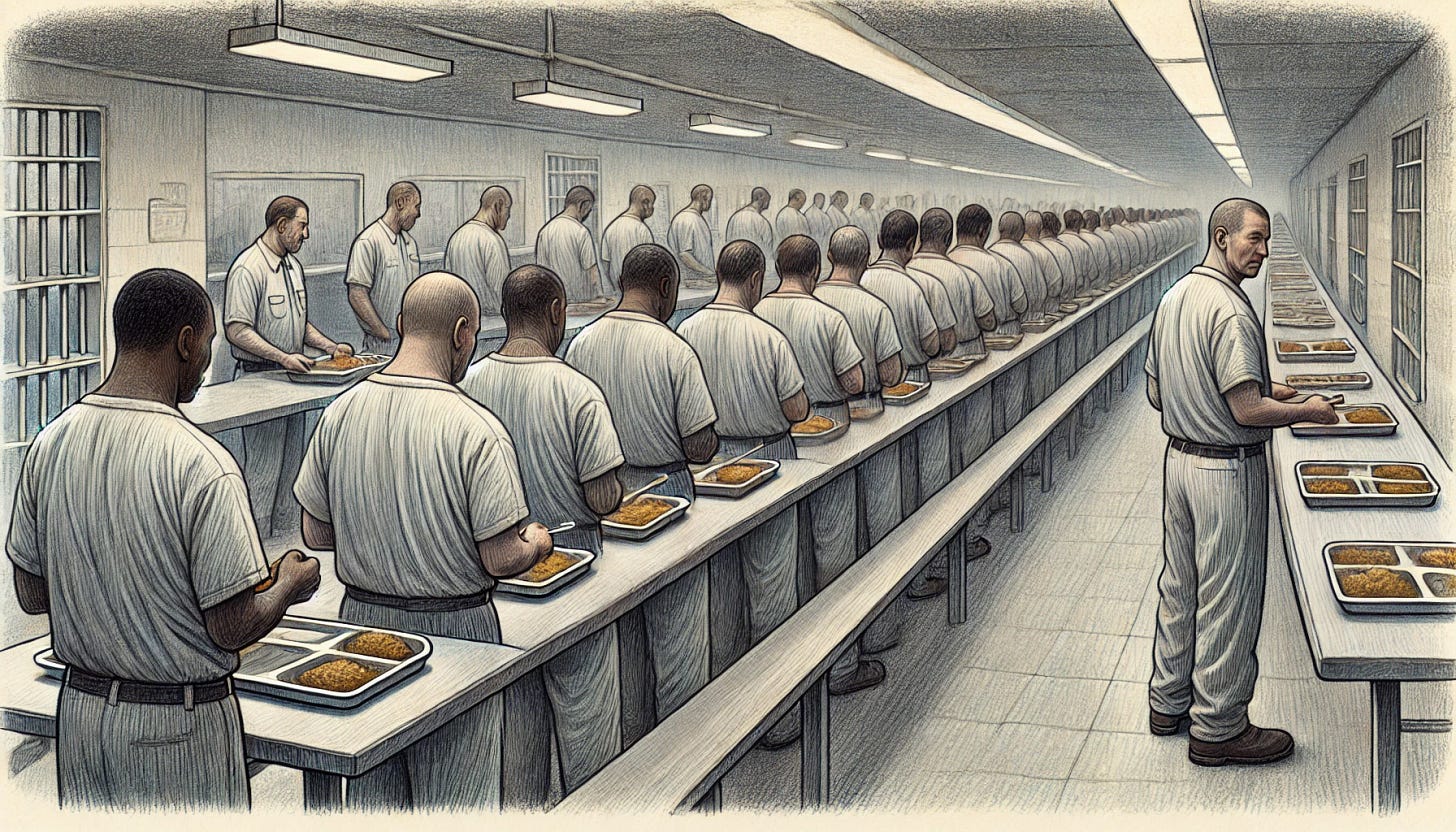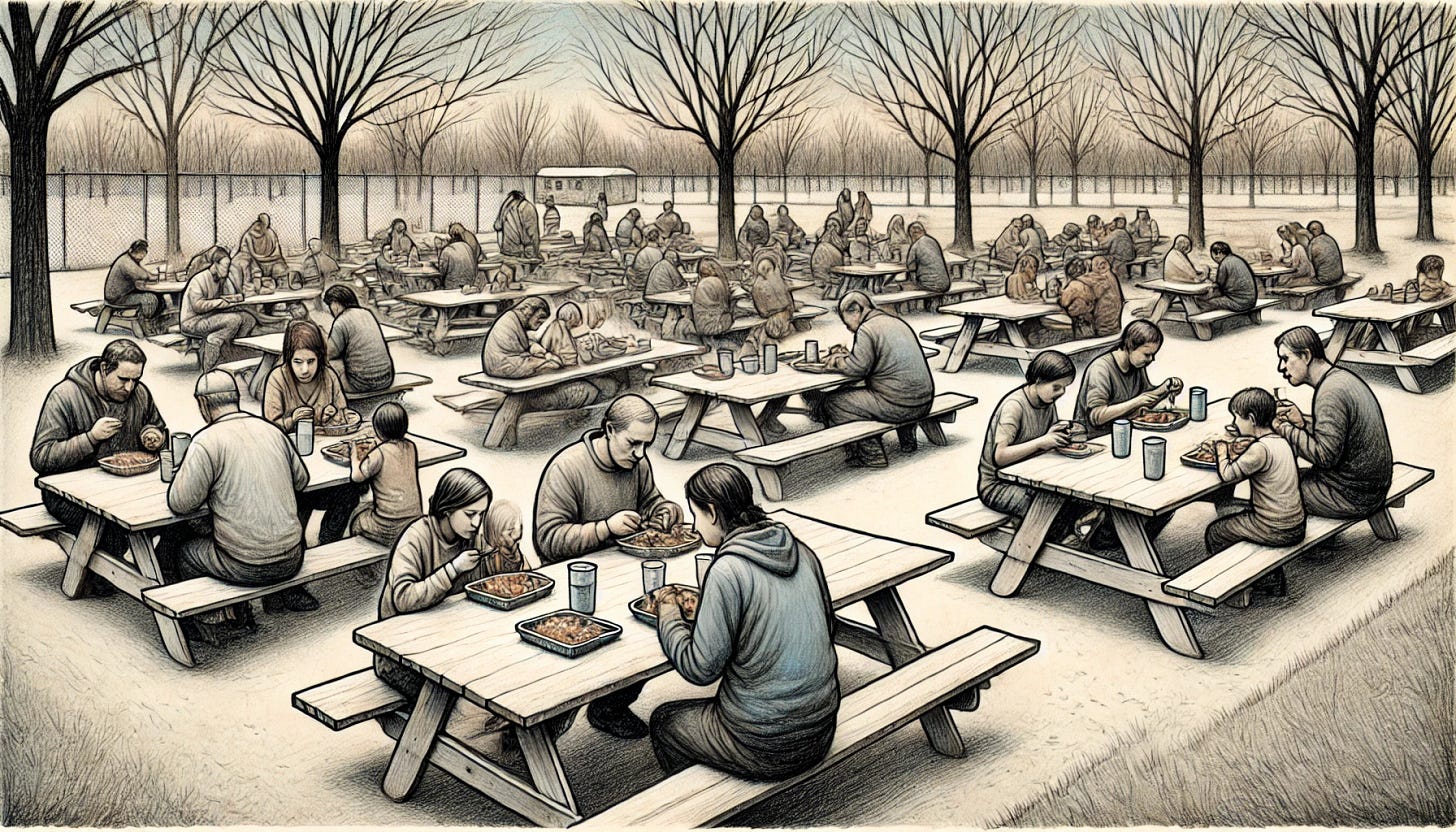The prison food playbook that feeds us all
A rigged food system profits off our plate; from cell blocks to school cafeterias, the fight to reclaim real food is just getting started.
In a Notes from the edge of civilization story in March, we talked about prison food as the "tip of the spear" in a weaponized food system. It’s a multi-billion-dollar grift where corporations like Aramark and Trinity Services profit by serving the incarcerated inedible slop, driving them to overpriced commissaries that the corporations also own. Neat trick, right? Hunger and deprivation as a revenue stream!
But that’s just the surface. The prison food racket isn’t an isolated abomination; it’s a microcosm of a broader machine that wields sustenance as a cudgel — for people behind bars, and those on the outside, too.
To truly grasp the scope of this issue, we need to peel back the layers: how did we get here, what’s at stake beyond the cellblock, and why does this weapon stay so sharp?
The modern prison food system didn’t spring up overnight
In the 1800s, the justice system viewed hunger as a moral chisel that could sculpt repentance out of deprivation. Privatization in the 1980s turned this crude disciplinary tactic into a profit engine. Companies promised leaner budgets and bigger savings, but instead delivered leaner meals — sometimes as cheap as a few dollars per prisoner per day — and pocketed the surplus.
Trinity Services, owned by private equity giant H.I.G. Capital, has seen its revenues climb even as complaints pile up over inadequate and unwholesome food. In a 2023 report from Impact Justice, three out of four formerly incarcerated people said they received trays with spoiled food (e.g., moldy bread, sour milk, rotten meat, slimy bagged salad mix, and canned or packaged products years past their expiration date).
What happens in the prison kitchen doesn’t stay there, however. It reverberates outward, exposing fault lines in how we feed ourselves everywhere. Incarcerated people spend an estimated $1.6 billion annually on overpriced snacks at prison commissaries, very much echoing the food deserts that plague low-income communities around the country, where fresh food is scarce and processed and packaged junk is ubiquitous.
Thanks to warriors like Zen Honeycutt, we now know American schools serve kids processed meats, sugary drinks, and meals chock full of glyphosate, harmful pesticides, neurotoxic heavy metals, and high levels of veterinary drugs and hormones. If what we’re feeding the next generation is unpalatable, just think of the Jell-O cups and salty snacks handed to patients in hospitals and nursing homes. When choices on the plate are that bad, vending machines hum with profit and Big Food racks up more revenue. The throughline is clear: when people can’t choose, corporations dictate — and they rarely opt for health.
It goes without saying this leads directly to a spike in chronic illness and behavioral issues. Good food could fix it, but it just doesn’t pay. Big Food — and by extension Big Pharma — know this.
We’re all in the chow line now
If Aramark and Trinity have a lock on serving inedible slop to the incarcerated, what the rest of us get is the same just dressed up in shinier packaging. Four corporations — Tyson, JBS, Cargill, and National Beef — control as much as 85% of America’s meat processing, as reported by the USDA.
Ten companies — Nestlé, Pepsico, Coca-Cola, Unilever, Danone, General Mills, Kellogg's, Mars, Associated British Foods, and Mondelez — own almost every large food and beverage brand in the world, accounting for billions of dollars in revenue every year.
Choice is an illusion. Pick your poison from their shelves and it’s almost certainly laced with glyphosate, the allegedly cancer-causing weed killer and desiccant that has seeped into 80% of US urine samples according to the CDC. Bayer recently said it may stop producing glyphosate, because the costs of cancer litigation keep mounting. But alternatives like dicamba may be even more toxic and more damaging to wildlife and the environment.
Many people see these trap and try to avoid them, but even that is becoming more difficult. Try growing your own food and, in many localities, you’ll slam face first into local zoning laws restricting backyard chickens, HOA rules outlawing gardens, or soil so tainted with lead and PFAs it’s a slow poison. Over 20% of US farmland is already contaminated, and the air is not much better: weather modification programs seed clouds with silver iodide, strontium, barium, aluminum — heavy metals that rain down onto our crops and go straight into our lungs.
Yes, there’s a big push for lab-grown meat, fake milk, and insect protein as “solutions.” These innovations aren’t really to help the planet or humans, but rather to pad Big Food’s bottom line. We’re all prisoners in this commodified food prison with invisible bars.
The battle’s not over yet, though — in fact, it’s really just beginning. Cracks in the system are starting to show and awareness is swelling, fueled by voices like John Klar, a Vermont farmer-lawyer exposing corporate ag’s stranglehold, and Meryl Nass, a doctor calling out chemical contamination in our food and water. Joel Salatin, the renegade farmer, proves you can defy industrial dogma with regenerative farming that heals soil instead of poisoning it. These messages are spreading — on X, on Substack, at farmers’ markets — and people are listening.
Grassroots movements only work if more people join in. The easiest way is to use the leverage of your wallet. Buy from those bucking the system, join a CSA, find a raw milk supplier, support a herdshare. Heck, just get to know your local farmer — stop in and introduce yourself next time you’re driving by. (Yes, it’s really that easy and farmers are some of the most approachable, most hospitable people in the world.) Best of all, every purchase you make from a little guy, starves the big corporate beast a little more.
We’re not entirely behind bars yet — and if we act now, we might never be.









I'm a registered dietitian and my very first job was as a food service director in a small nursing home. We were so small, that I ended up cooking meals. I was able to hire some staff but some of those people had no cooking skills. I know the cafeteria manager in my kids elementary school had no food service/culinary experience. Convenience foods and those "big food" companies mean nursing home pts now get RTE heat and serve foods. We have lost those skills as a society. As a result, we really on those food companies. I don't know the answer, but it's definitely a problem.
Food is a very effective weapon, look whats happening in Gaza .
Many people are obese but are still malnourished because of the ways you have so clearly outlined in this article.
Have you read Fiat Food ? It is an excellent read about the take over of the American food system and the lies it’s based on.